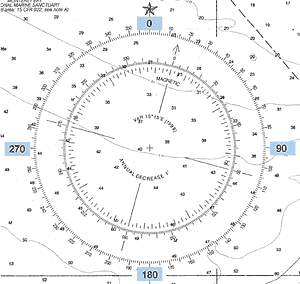While on board the Team O’Neill Catamaran, each group took a set of three bearings with the compasses. A bearing is the direction of an object from the observer expressed in degrees. The object we are looking at must be something we can find on our chart. It is usually a navigational aid like the mile buoy, the lighthouse, or something easy to identify like the flag on top of the boardwalk. It cannot be something that we won’t find on our chart, like another boat, a sea lion, or your friend on the bow of the boat. Remember that a compass is a circle divided into 360 degrees. So all bearings will be a number between 0 and 360 degrees. The bearing for North will be 0 or 360 degrees because our circle begins and ends in the same place. The bearing for south is 180 degrees.

Many people who first learn navigation confuse a bearing and a heading. The heading is the direction in which the ship is moving, or where the bow of the ship is pointing.
A compass has many parts. The part of the compass that shows directions and degree markings is called the compass card. On the handheld compasses we used on board the Team O’Neill, the compass card moved, so that it was always pointing towards north. The line on the compass that lines up with the degree markings on the compass card is called the Lubber’s line.
Questions:
The compass is a Chinese invention that dates back to 100 AD when Chinese fortunetellers noticed that lodestones (a mineral composed of iron oxide) align themselves in a north-south direction.
True north refers to the north pole of the earth where all the lines of longitude come together. The magnetic north pole is the most magnetic place on the surface of the earth, produced by the earth’s magnetic field, in northwestern Canada.
